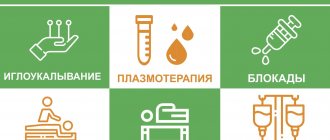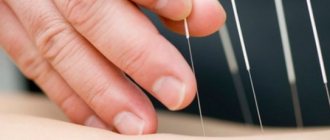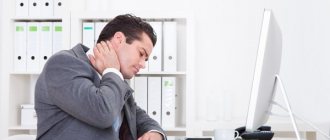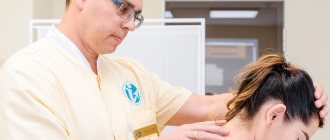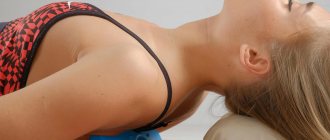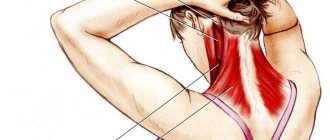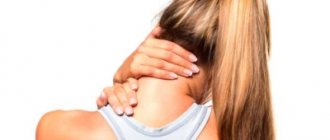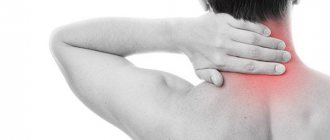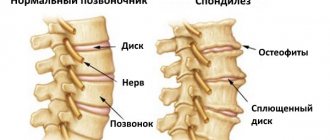The formation of protrusion of the intervertebral discs of the thoracic spine is regarded as a formidable harbinger of the formation of a hernia, which can significantly reduce the quality of life, and in especially severe cases, lead to irreversible changes, including disability. Therefore, protrusions of the thoracic spine, although they occur much less frequently than in the cervical and lumbar spine, receive a lot of attention.
Causes
There are many factors that cause protrusion of the discs of the cervical spine. Knowledge of these factors will allow you to determine whether you are at risk and what was the impetus for the development of pathology in your case.
Excess body weight
Excessive weight of the patient is a consequence of the fact that additional loads are placed on the spinal column. A person needs to spend much more effort on each action, and accordingly, the resource of joints and cartilage ends faster. In addition, overweight people often lead an inactive lifestyle, which contributes to the development of diseases, including protrusion in the cervical spine.
Lifting weights with axial overload
Sudden lifting of heavy loads causes a “breakdown” of the back, sprained ligaments, and damage to cartilage and muscle structures. Therefore, if you play sports or your work involves lifting heavy weights, you need to know that your back is not involved in the process of lifting something heavy - you need to lift it with a load on the leg muscles.
Making sudden turns of the head (for example, when doing exercises)
Protrusion of intervertebral discs in the cervical spine can occur when sudden movements occur. During inaccurate movement, and especially with load, it is very easy to damage the soft structures of the spine. As a rule, sudden movement becomes the cause of pathology when the prerequisites for it already exist.
Age-related changes
With age, cartilage tissue in the body loses its elasticity, becomes thinner and less durable. The consequence of this is protrusion, which can occur even with minimal stress on the body. In addition, other diseases, such as osteochondrosis, can lead to it.
Poorly developed muscle frame
A person who neglects physical activity will have to learn about the symptoms and treatment of protrusion of the cervical spine. The thing is that the intervertebral cartilages are nourished by the muscles adjacent to them. Accordingly, the better blood circulation in the muscles, the healthier the discs between the vertebrae will be. With poor muscle development, there are often congestive processes in the back.
Red flags for neck pain
A serious underlying cause is more likely in people who:
- The onset of symptoms appeared before the age of 20 years or after 55 years.
- Weakness involving more than one myotome or sensory disturbance involving more than one dermatome.
- Intense or increasing pain.
Red flags suggesting possible malignancy, infection or inflammation:
- Fever.
- Unexplained weight loss.
- History of inflammatory arthritis.
- A history of malignancy, drug abuse, tuberculosis, AIDS, or other infection.
- Immunosuppression.
- Pain that gets worse, is very intense and/or disturbs sleep.
- Lymphadenopathy.
- Local point tenderness over the vertebral body.
Red flags suggesting myelopathy (spinal cord compression):
- Progression of symptoms.
- Gait disturbance; weakness or impaired motor function in the hands; loss of bladder/bowel control.
- Lhermitte's sign (bending the neck causes an electric shock sensation that travels down the spine and into the extremities).
- Pathological symptoms in the lower extremities (Babinski reflex, hyperreflexia, clonus, spasticity) and in the upper extremities (atrophy, hyporeflexia).
- Various sensory changes (loss of proprioception more noticeable in the arms than in the legs).
Red flags indicating the possibility of severe skeletal injury:
- Trauma history.
- Previous neck surgery.
- Osteoporosis or risk factors for osteoporosis.
- Increase and persistence of pain.
Red flags indicating vascular insufficiency:
- Dizziness and darkening before the eyes (compression of the vertebral artery) when moving, especially when straightening the neck.
- Dizziness, syncope episodes.
Degrees of cervical protrusion
Protrusion does not appear immediately; its occurrence occurs in stages. Namely:
- The first stage of the pathology is when the disc pulp shifts to the side and begins to put pressure on the wall of the fibrous ring. At this stage, it is difficult to detect pathology, since it does not manifest itself and is often diagnosed by chance when doctors are looking for another disease.
- The second stage - the size of the protrusion increases greatly, as a result of which it puts pressure on the nearby nervous tissue, the person feels pain and encounters other unpleasant manifestations of the protrusion.
- The third stage is the rupture of the ring that holds the contents of the disc. This is the final stage of protrusion, when an intervertebral hernia occurs.
That is why protrusions of the cervical spine, the symptoms and treatment of which will be described below, cannot be started. An intervertebral hernia in itself can lead to disability of the patient.
Diagnostics
An experienced neurologist should diagnose dorsal protrusion of the intervertebral disc. Having studied the clinical picture of the disease and the symptoms that bother the patient, as well as carefully examining the patient, he will be able to make an appropriate conclusion. For accurate diagnosis, the following diagnostic methods are used in medical practice: magnetic resonance imaging, computed tomography, radiography. The integrated use of the above methods makes it possible to establish the nature of the spinal pathology, the stage of disc protrusion and its size. Thus, accurate, complete and truthful data will be obtained, and most importantly, the presence of “protrusion” of the disc in the direction of the spinal canal will be revealed. Magnetic resonance imaging shows the highest efficiency in diagnosing dorsal protrusion of the intervertebral disc. It allows you to establish the extent of the pathology, as well as timely determine the progression of other processes.
Timely seeking help from an experienced doctor allows you to cope with spinal pathology in eighty percent of cases. To do this, it is necessary to establish the pathology, its size, the presence of complications, and the cause of the disease. Accurate diagnosis will determine the presence of protrusion even in the early stages, will distinguish dorsal disc protrusion from other spinal ailments, and will also play a key role in prescribing correct and effective treatment.
Symptoms
The symptoms of this disease are disguised as manifestations of other pathologies. Doctors often send their patients for a cardiogram and vascular ultrasound because they believe that the problem is a disease of the cardiovascular system.
Coordination of movements is impaired
Treatment of protrusion in the cervical spine is often necessary after a person consults a doctor with complaints of coordination problems. They appear due to the fact that the nerves compressed by the protrusion do not function properly. In some cases, vision is even impaired.
Strong headache
This is due to the constant impact on the nerves. The pain can spread along the nerve and is disguised as a severe migraine, which is not relieved by medications.
Blood pressure is unstable
Often among the symptoms of protrusion of intervertebral discs in the cervical spine are sudden changes in blood pressure. They are due to the fact that muscle spasms in the affected area lead to compression of large blood vessels.
Kinds
The intervertebral disc itself has an ellipsoidal shape, i.e. close to a circle. The formation of a protrusion can occur in any part of it, which is the main classification criterion. Determining the type, i.e., the position of the protrusion is very important for developing the correct treatment tactics. Therefore, increased attention is being paid to this issue.
The intervertebral disc is conventionally divided into 2 parts: posterior and anterior. The posterior one forms the spinal canal, in which the spinal cord passes, and the anterior one adjoins the soft tissues in the direction of the abdomen. Therefore, it is the posterior protrusions, which are also called dorsal, that pose the greatest danger. The front ones are practically harmless and rarely require treatment.
Depending on which part of the posterior surface of the disc the protrusion is formed, there are 4 main types:
- median – located clearly in the center of the spinal canal and can provoke the occurrence of disorders on both the left and right sides of the body;
- paramedian - displaced relative to the central axis to the left or right and, accordingly, causes symptoms to appear in the left or right side of the body;
- foraminal - formed in the area of the natural openings of the spine, formed by the pedicles of the vertebrae and the articular processes of neighboring vertebrae, through which the spinal roots pass;
- diffuse - the protrusion occupies most of the posterior surface of the disc and can cause severe neurological disorders.
Treatment options
What to do if you have a protrusion of the cervical spine, your attending neurologist
. Protrusion is treated with:
- Medicines - chondroprotectors, analgesics, anti-inflammatory drugs, anti-edema drugs, vitamin-mineral complexes, drugs to improve blood circulation.
- Exercise therapy.
- Physiotherapy and manual therapy.
You cannot treat yourself, since therapy is prescribed only based on diagnostic results.
How to treat effectively and inexpensively?
For successful therapy, it is necessary to combat the two main reasons described above - muscle spasm and tightening of the spine. Several processes underlie muscle relaxation:
- Activation of proprioceptors (this is a signal to the brain about muscle transitions from a tense state to a relaxed state)
- Creating ischemic compression (oxygen starvation, muscles do not receive nutrition and relax)
- Stretching a muscle (in a tense state the muscles are contracted, in a relaxed state they are stretched).
Activation of proprioceptors is the most effective method. Since not all paravertebral muscles can be mechanically limited in nutrition or stretched. Ideally, therapy combines all three methods.
Therapy combining all three methods can be obtained either from a qualified specialist or using special devices. The specialist must not only straighten the vertebra, but also work the muscles. This cannot be done in one session - you need to be prepared for this.
Prevention
Preventing the occurrence of protrusion is easier than treating it. However, to do this you will have to reconsider your lifestyle and:
- add more physical activity if you have a sedentary lifestyle - walks in the evenings, visiting the pool or gym, etc.;
- give the body the necessary rest;
- give up alcohol and smoking;
- balance the diet;
- properly organize your workplace and sleeping area.
To see what the pathology looks like, you can watch a video of a protrusion of the cervical spine on the Internet and conclude that its occurrence is associated with great discomfort.
Forecast
Spinal protrusion can be successfully treated , but some doctors believe that the prognosis is disappointing if the disease is diagnosed after 50 years.
Protrusion, of course, is not a fatal disease, but it significantly reduces the quality of life. The duration of therapy and its success depend on the stage of the disease and the patience of the patient.
It can be argued that modern treatment methods in combination with exercise therapy, massage and physiotherapy successfully fight the disease . But it is necessary that the patient wants to get well and takes treatment very seriously. Any pathology of the spine requires special attention.
Benefits of MBST Therapy
Thanks to MBST therapy, blood circulation improves, regeneration increases and muscle tension decreases. The main advantage of the technique is the absence of adverse reactions and contraindications. This procedure is not dangerous for the patient and allows you to cope with the disease without the use of chemicals.
In just 10 sessions, you can eliminate negative symptoms and cope with the cause of thoracic protrusion. It is MBST therapy that will allow you to avoid surgical intervention and help completely restore the thoracic spine.
